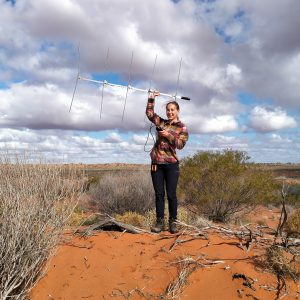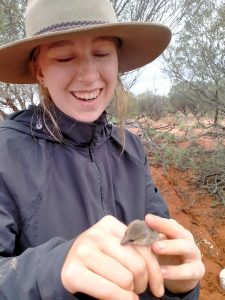

Tessa Manning, a PhD student at the University of Adelaide has been provided a grant to assist in her PhD project involving Red-tailed Phascogales. The grant will be used to assist in her work focusing on the reintroduction of the species at two sites in South Australia.
Introduction
Red-tailed phascogales (Phascogale calura) are near-threatened and have been extirpated from 99% of their original range. The species is extinct in South Australia but two projects aim to reintroduce red-tailed phascogales to South Australian landscapes in the next two years. I aim to support these reintroductions with genetic history work, dietary, breeding, and habitat use studies. My results will contribute to best-practice reintroduction techniques by determining optimum habitat and key dietary items which will improve site selection for future reintroductions of red-tailed phascogales to Australian landscapes.
Red-tailed phascogales will be reintroduced to Secret Rocks Nature Reserve on northern Eyre Peninsula, and to the Vulkathunha-Gammon Ranges National Park (VGRNP) in the northern Flinders Ranges. The two reintroductions are facilitated by Ecological Horizons (owners and managers of Secret Rocks), and the South Australian Department of Environment and Water (VGRNP). Secret Rocks Nature Reserve is a fenced feral-predator-free reserve, predominantly consisting of mallee (Eucalyptus socialis, E. dumosa, E. oleosa, E. porosa, etc.) and mixed Triodia spp. and Acacia app. understory. The VGRNP is baited for cats and foxes, but is unfenced. The habitat is mixed with sparse Eucalyptus socialis woodland, Casuarina pauper slopes, E. intertexta and E. camandulensis creek lines, and thick Melaleuca lanceolata creek lines.
Red-tailed phascogale research has, to date, been conducted in the woodlands of the Western Australia wheatbelt, or at Alice Springs Desert Park. The two areas red-tailed phascogales are being released in 2022 are therefore unique and my research will help other reintroduction practitioners to understand how red-tailed phascogales use different habitats and help define what a suitable habitat might look like for future reintroductions.
I aim to compare the success of two different red-tailed phascogale reintroductions by:
- Radio-tracking them to their daytime shelter sites, comparing characteristics of those shelter sites at the two locations
- Using radio-tracking data to locate the phascogales at night and observe their night-time foraging and habitat use behaviour, looking into behavioural differences between the predator-free and low predator density sites
- Collecting scats to determine diet in the two different habitats and determining seasonality of diet and resource availability
- Investigating breeding success at the two locations by sampling genetic material to look at parentage of young, genetic diversity, and differential male success rates
Additionally, I aim to investigate the phylogeographic history of the red-tailed phascogale by analysing DNA from museum specimens to determine if there was more than one sub-species or species of arid-adapted phascogales across the red-tailed phascogales vast former range.
Methods
The reintroduction teams at both sites will radio-track individual animals using tiny VHF radio collars to their daytime shelter sites and gather information on shelter type (e.g., tree hollow, under bark, rock crevice, base of tree, nest box), thermal properties of shelter sites, and characteristics of surrounding habitats. I will primarily radio-track the same individuals at night to determine their night-time foraging habits such as time of emergence from shelter, time spent on the ground, and on what they forage. I will also observe them at night for predator response behaviours. For the night-time observations I plan to use a thermal monocular or binoculars, or night-vision equipment to help me find animals while being far enough away that I won’t disturb them.
For the dietary study, the reintroduction teams and I will collect scats opportunistically while trapping phascogales for collar checks, or during monitoring. If the animals use any nest boxes, we will also periodically check nest boxes for scats. The laboratory methods for the dietary study will involve creating a DNA library of potential prey items (e.g., insects, lizards, snakes, birds, and flowering plants present at each study site, noting an extensive Flinders Ranges plant DNA library was recently established for the reintroduced brush-tailed possum diet study, and GenBank already contains representatives of major genera and insect Orders), then amplifying and sequencing the DNA present in scats. I will then match sequences found in scats against the library to obtain matches with prey items. I will then be able to identify dietary items and run statistics in R to gain information on seasonality, dietary diversity and richness,
and dietary change over time.
For the breeding study, the reintroduction teams and I will need to take DNA samples from all founding animals and as many offspring as possible. To do this we will need to take samples from founders before release, and then re-trap females with pouch young or identify dens in July/August of each year. Additionally, we should be able to trap some dispersing young in November/December and take DNA samples from them. For the laboratory component, I will use SNPs to identify individuals and then run the sequenced data through parentage analysis software like CERVUS. Combining the parentage information with radio-tracking and individual identification in the field, I will be able to identify who is occupying which home range and what their relationships may be (e.g., mother/daughter sharing a home range).
For the phylogeographic study, I will collect DNA from museum samples held across Australia, and perhaps internationally. I will extract and sequence mitochondrial DNA, then conduct phylogenetic analyses to determine if there was any geographic structuring across the species former range. I will use thresholds of differentiation and confidence to validate my results.
I have been included on both the Secret Rocks and Department of Environment and Water ethics permits for phascogale research. I am currently also applying to the University of Adelaide ethics committee. I am currently applying for scientific research permits for both my study locations.
Schedule
My project will run at two sites simultaneously, the Vulkathunha-Gammon Ranges National Park (VGRNP) and Secret Rocks Nature Reserve (SRNR).
In the time between field sessions, I will work on acquiring samples from museums and processing them in the lab for my phylogeographic study. I will work on the lab components of the dietary study, extracting and processing DNA from the scats collected in the field. By the end of November 2022, I should have some DNA from juveniles, I will be able to process this to determine parentage of the first generation of a sample of offspring born in the reintroduced populations. I will use my time between field sessions to process field data, including mapping home ranges and understanding habitat characteristics